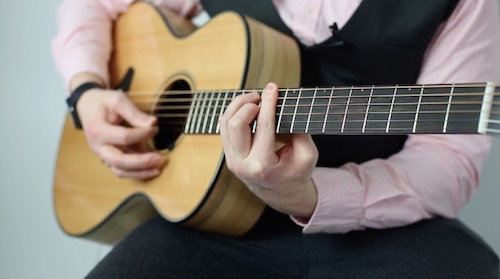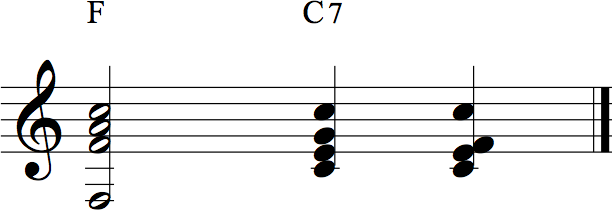怎样弹奏吉他和弦转换

Barre Chords Technique Hi, I'm Grey and this is Hub Guitar. Let's talk about the overall technique needed to successfully play barre chords. I'll preface this with saying that most beginners should avoid barre chords, for at least 6 months. It's a big obstacle to learn to play barre chords and it depends on your physical conditioning. There's alot of other things you can do instead while you work up the strength to play barre chords. A barre chord is when you use a single finger from the fretting hand, normally the index finger, and push down multiple strings at the same fret. One of the first barre chords that players usually encounter is the F major barre chord. And that's ironic because it's also a fairly difficult barre chord. This chord works by fretting across the entire first fret with the index finger, and then with the remaining fingers, you create an "E Major" chord shape. So if this is E Major--notice that I'm using middle, ring and pinky to create it-- and then it up one fret, and barre across the entire first fret. My students are sometimes surprised to find that as a guitar player, I don't usually play this chord in this way. I don't really like to barre chords in the open position. There's usually an easier way to play an F chord. And I like to play things the easy way. When you practice barre chords, you should start with the easiest ones and move your way towards the harder ones. That makes "F Major" a poor choice, because it's among the harder ones. Actually, barre chords are largely a function of strength. So practicing really hard barre chords will help you build that strength. But if no pleasant sound is coming from your guitar when you practice, you're not going to practice long. So what makes barre chords more easy to play? 1 - Barre chords in the center of the neck, around Fret X or so, will be easier. That's because the tension of a string feels lighter in the middle than it does at either end. 2 - Barre chords where the finger doing the barre is not responsible for pressing the middle strings are easier. For example, in the F major shape we talked about, that's easier than an F7. F7 requires us to lift up the finger on the fourth string, and now the barre is responsible for playing four strings instead of 3. And one of those four is in the middle and it's very hard to transfer the force from the barre into that string. 3 - Barre chords on a properly set up guitar are easier to play. If you spend less than $1,000 on your guitar and you did not have it set up by a professional before, chances are your guitar is not properly set up. Setup refers to the string height and all kinds of tiny little adjustments that are made by a professional to make the guitar easy to play. Only very expensive instruments will arrive from the factory set up properly. The rest will usually need adjustments. The store selling the instrument is supposed to do these adjustments. But they are often done hastily--if at all. 4 - Barre chords on a guitar with lighter strings will be easier. The strings are thinner and easier to push. 5 - Barre chords on a guitar with detuned strings are also easier. So you can actually tune down the pitch of every string by an equal amount. Now there will be a little bit more slack on the string length between the nut and the saddle, and thus the string is easier to push. So knowing what we now know, we can come up a practice routine that takes that into account. I'm going to go to the Xth fret and play a D major, and then switch that shape down one string to create a G minor. And that's a fairly easy motion; same shape. I'm going practice back and forth, making sure all of my notes are nice and clean and I'm pressing firmly. Then I'm going to slide that whole thing down one fret and repeat. Db Major and Gbmajor. And I can continue all the way down the neck. The frets are getting larger, and the strings are feeling tighter. Once I've mastered that, I can go back to the Xth fret and try it again with a harder chord progression, like D7 to G7. Now my barre has to do some of the notes in the middle of the chord on strings 34 and 5, so it's getting harder. And then I work my way back down. So that's it. If barre chords are difficult for you, find a way to make them as easy as possible. And practice them slowly, until they become more and more easy.
初学者还有一个面临的问题就是和弦转换。前后两个和弦之间总会有停顿几秒的感觉,你可以感受一下就是车子熄火,再启动的状态。
在扫弦模式里留给自己更多时间
这里是一个比较简单的方法来调整扫弦模式,让你在A、B和弦之间转换的时候有更多的时间。

这个例子里,第一个和弦模式,如果你重复这个和弦的话会卡住,但如果你把最后那个音去掉的话,你就有更多时间回到C和弦手形了。
与其弹很复杂的扫弦模式(大概只有八分音符的时值转换和弦),不如专门弹稍微容易转换的那种和弦模式。你可以试试block chordsA simplified accompaniment consisting of one chord per chord change. The chords are just played once as they occur and allowed to fade away.,这种和弦至少给你一小节的时间来转换的下一个和弦。

现在越来越多人开始用柱式和弦(block chords)。
希望这句笑话能翻译好了
有一些初学者对这个概念有些疑惑,心想“这难道不是作弊吗?”,“我不是应该有效率的转换和弦吗?所以不是应该只弹奏简单的和弦模式吗?”
但事实是,所有的吉他手都在自己能力水平范围内弹奏,每秒扫弦64次肯定是不可能完成的任务—没人会去这样做。你现在如果对转换和弦有困难的话,那你就是需要提高自己的水平。所以放心大胆的调整一下难度系数,还能帮你进步呢。这样做你可以在你提高水平的过程中不断学习其他的东西。

一节内64次扫弦,算了,我还是不要了。
当你在学习过程中遇到了障碍,别停下来,把这块大石头推走,或者绕过它。只要我们觉得实际可操作,不存在作弊这个说法。
调整和弦
想法:如果你觉得在这两个和弦之间转换很难,那就把其中一个,或者干脆两个都变得简单点。
不,这也不是作弊。聪明的学生可以根据需要,把音乐改变至适应他们的能力水平。没有人规定你一定要弹乐谱上给你的一模一样的音乐。
另外,如果你没能在E7和A-7之间成功转换的话,那这就不是一个好的练习,因为失败在练习中不是一个好兆头。把和弦变得简单点,而且适应你水平,这让你能够顺利的弹和弦转换。渐渐的你会发现你能够弹越来越难的和弦了。
你要先学习一下music theory,这可以让你知道你可以用哪个和弦作为替代。很多吉他手一提到音乐理论就马上逃走,讽刺的是这是少数可以让你的学习变得简单一点的东西。
部分和弦转换

另一种可以提高你和弦转换的方法是,先转换部分和弦—转换快完成是还是继续扫弦。或者改变扫弦模式,只扫正确被转换的那部分和弦,直到你最后完成转换。
积极练习和弦转换
接下来是最最重要的小贴士啦。
你先心里默默想一个乐曲里面有一个很难的和弦转换你老是弹不好的。
这首歌3分钟左右,每次你都没法弹好这个和弦转换。
同时再想象完全掌握这个转换要5,000次的重复练习。
如果你每次练习这个和弦转换都弹一遍这首歌的话,那你要弹这首歌5,000次来完全掌握这一个和弦转换,你总共等于花了250个小时来学一个和弦转换,因为这首歌总长3分钟。很明显,这不是个有效方法。
现在,我们再算一下如果你只练习这个和弦转换,不断重复。一开始的时候,每次转换要几秒钟,但是马上你就可以做到1分钟50次,当你到这个水平以后,你可以在1个半小时内练习这个和弦转换5,000次。
就像是你把这项艰难的任务拆分以后分别练习,最后再重新组装。
尾声
如果你觉得和弦转换很困难的话,尝试改变调整一下和弦或节奏,让它们变得简单一点。而且专注在练习转换上直到你很熟练为止。
 As the creator of Hub Guitar, Grey has compiled hundreds of guitar lessons, written several books, and filmed hundreds of video lessons. He teaches private lessons in his Boston studio, as well as via video chat through TakeLessons.
As the creator of Hub Guitar, Grey has compiled hundreds of guitar lessons, written several books, and filmed hundreds of video lessons. He teaches private lessons in his Boston studio, as well as via video chat through TakeLessons.